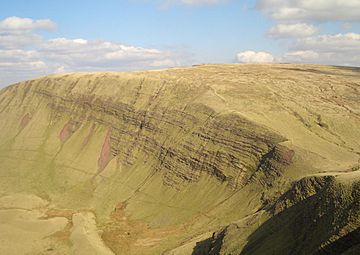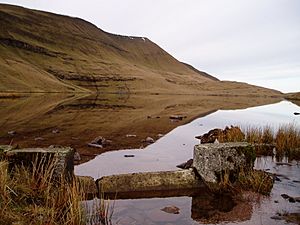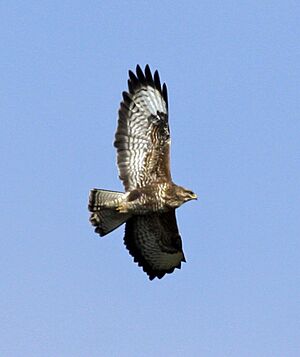Fan Brycheiniog facts for kids
Quick facts for kids Fan Brycheiniog |
|
|---|---|

Fan Brycheiniog from Picws Du
|
|
| Highest point | |
| Elevation | 802.5 m (2,633 ft) |
| Prominence | 425 m (1,394 ft) |
| Parent peak | Pen y Fan |
| Listing | Marilyn, Hewitt, Nuttall |
| Naming | |
| English translation | Brecknock beacon |
| Language of name | Welsh |
| Geography | |
| Location | Powys, Wales |
| Parent range | Brecon Beacons |
| OS grid | SN825217 |

Fan Brycheiniog is the tallest mountain in the Black Mountain area of the Brecon Beacons National Park in southern Wales. It stands at 802.5 meters (about 2,633 feet) above sea level. At the very top, you'll find a special marker called a trig point and a stone shelter where you can rest.
This mountain is located in the historic county of Brecknockshire, which is now part of the Powys council area. That's where the mountain gets its Welsh name! A smaller peak nearby, called Fan Foel, is the highest point in the neighboring county of Carmarthenshire. Fan Brycheiniog is also part of the Fforest Fawr Geopark, which was created to protect the area's amazing geology. When the weather is clear, the views of the open countryside are incredible, showing how wild and isolated this mountain range is compared to the busier Pen y Fan area.
Contents
Exploring the Mountain: Access Routes
The Beacons Way is a special long-distance walking path that goes right along the top of Fan Brycheiniog. It starts from Llanddeusant and heads southwest. After passing the summit, the path goes down towards a large lake called Llyn y Fan Fawr, which is east of the peak.
You might cross some wet, spongy areas called peat bogs on the path, but don't worry! In many places, there are stone paths to keep your feet dry. There's also a clear stone staircase that leads down the steep side of the mountain to the lake below. It's easy to follow and usually dry.
This path continues to other peaks like Picws Du and Waun Lefrith, which are above a smaller glacial lake called Llyn y Fan Fach. Fan Foel, Waun Lefrith, and Picws Du are sometimes called the Carmarthen Van because they are all within Carmarthenshire county.
Mountain's Makeup: Geology
Fan Brycheiniog is made of different types of rock, mostly sandstones and mudstones. These rocks are part of something called the Brownstones Formation, which comes from the Old Red Sandstone period, a very long time ago in the Devonian period. The very top of the mountain and its southern slopes are made of even harder sandstones from the Plateau Beds Formation.
Water from the cwm (a bowl-shaped valley) below the summit flows into the River Usk to the north. Water from the southern slopes goes into the Afon Twrch, and water from the eastern slopes flows into the River Tawe. The soil on the mountain is thin and acidic because of the large areas of peat bog.
You'll find plants like tussock grass, cotton grass, bilberry, heather, and many kinds of moss here. This is because the mountain gets a lot of rainfall! Further down the mountain, these rocks meet Carboniferous Limestone, which creates a unique landscape with caves and sinkholes.
Fan Foel: A Special Peak
Northwest of the main Fan Brycheiniog summit is a noticeable smaller peak called Fan Foel. It stands at 781 meters (about 2,562 feet) above sea level. This makes it the highest point in the county of Carmarthenshire!
Fan Foel sticks out from the main mountain ridge, forming the northernmost part of the cliffs in the area. It's a very important landmark. From its top, you get amazing views over the open moorland below. The views are even wider than from the main peak because Fan Foel is more exposed to both the east and west. There's a clear footpath that goes down from the peak to the moorland. Two other peaks, Waun Lefrith and Picws Du, are also along the ridge to the west.
Ancient Discoveries: Archaeology

At the top of Fan Foel, there's an ancient Bronze Age burial mound, also known as a cairn. This mound was dug up by archaeologists between 2002 and 2004, and their findings were published in 2014. The mound was about 16 meters (52 feet) wide and had been damaged over time, with stones taken by walkers to build a small pile in the middle.
When they dug into the mound, archaeologists found two separate burials. The main burial was in a stone box called a cist. Inside, they found the burnt bones of an adult woman and two children. Scientists used Radiocarbon dating to figure out that these remains were from around 2000 BC. The ground surface under the mound was even older, dating back to about 2300 BC. The cist also held a broken pottery food vessel, decorated in the style of the Beaker culture, and a chert knife.
The second burial was a bit newer and contained a broken pot called a collared urn, along with a rare belt hook. This suggests the person buried there was quite wealthy. Amazingly, remains of Meadowsweet flowers were found in the main cist. These might have been part of a wreath left with the burnt bones. The large stone lid covering the cist is still in place today, and you can see the outer stones that show how the mound was built. These Bronze Age mounds are similar to others found on Pen y Fan and Corn Du.
Scientists also studied the ancient soil under the mound by looking at pollen. They found that before the mound was built, the top of Fan Foel was covered in grass and heath plants. Lower down the slopes, there were hazel bushes and mixed woodland with lots of oak trees. They also found Charcoal in the buried soil, which could mean people were burning the land to grow crops better, or perhaps they used fires as a beacon (a signal light), which fits with the name of the Brecon Beacons range. You can even see Pen y Fan and Corn Du from here, about 15 miles away! The climate back then was warmer than it is now, which allowed people to live and farm in these high areas during the British Bronze Age.
Amazing Animals: Wildlife


This area is home to many different kinds of birds! You might spot a red kite, a common buzzard, a kestrel, a carrion crow, a common raven, or a skylark. Kestrels and buzzards are common, but ravens usually stick to the higher mountains. On a clear day, you can often see these large birds soaring high above the summit. They use warm air currents called thermals or updrafts from the valleys below. Buzzards sometimes fly in groups.
You might also see game birds like the Red grouse, Partridge, and Pheasant. Luckily, birds of prey here are not hunted as much as in other mountain areas, so they are doing very well. The Red Kite, for example, survived many years of hunting in this area. Thanks to groups like the RSPB, red kites have now spread and repopulated much of England and Wales.

